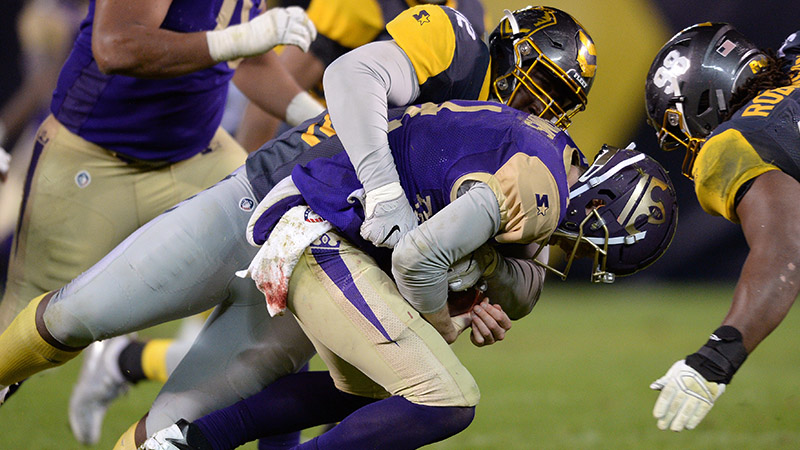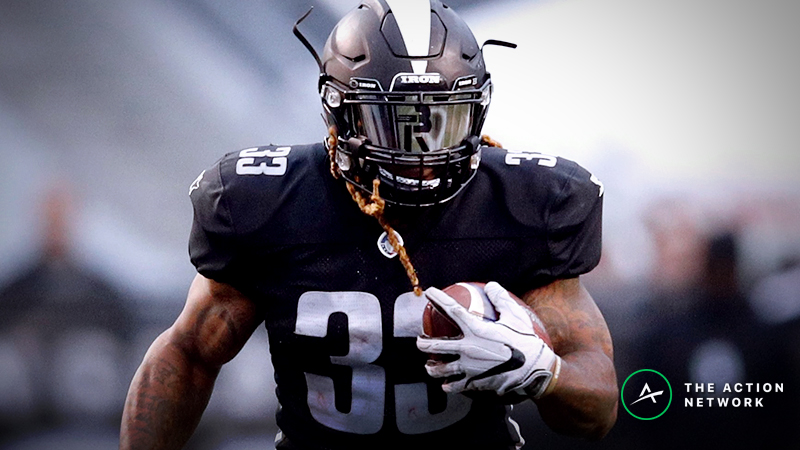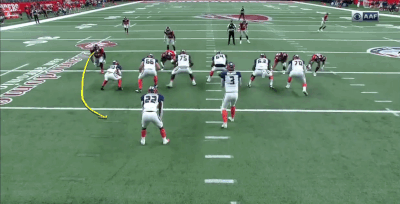Week 2 of the Alliance of American Football league provided more high-level football than viewers saw during the league’s inaugural week. I’m proud — and slightly concerned — to say I haven’t missed a snap of this wonderful new league, as even horrendous football is better than no football at all.
NFL: We’ve never seen an in game pass as crazy as the Mahomes no looker!
AAF: Hold my beerpic.twitter.com/Uz5P6ZTty9
— The Action Network (@ActionNetworkHQ) February 18, 2019
We still have an incredibly small sample size to work with, but 120 minutes of game film at least gives us the chance to begin to identify which teams could ultimately contend for championship glory, as well as which teams suck and should be mercilessly gambled against.
What follows is a look at each team’s best position group as well as some key workload and production notes ahead of Week 3.
All odds via the Westgate Las Vegas SuperBook, as of Monday evening.
Arizona Hotshots
Odds to win the AAF: 2-1
Best position group: Quarterback
John Wolford has emerged as one of the AAF’s premiere talents under center. Overall, he’s completed 32-of-51 passes (62.7%) for 470 yards (9.2 Y/A) with a league-high six touchdowns to go against two interceptions. He’s also converted 15 rushes into another 48 scoreless yards on the ground.
Wolford’s consistent excellence under center has helped produce a star out of No. 1 receiver Rashad Ross.
Rashad Ross is looking like the best receiver in @TheAAF after two weeks.
11 targets
9 receptions
170 yards
3 TDs pic.twitter.com/WIfg8sxGDv— Ian Hartitz (@Ihartitz) February 17, 2019
Arizona’s comeback victory against the Memphis Express in Week 2 came without the services of their starting left and right tackle.
Head coach Rick Neuheisel deserves plenty of credit for putting together arguably the league’s most modern scheme on offense through two weeks, as Wolford leads all quarterbacks in quickest time to attempt (2.39) and ranks second in play-action percentage (30.6%).
Additional notes:
- Ross (12 targets) has easily been the team’s No. 1 receiver. The likes of Richard Mullaney (nine), Josh Huff (eight) and Gerald Christian (seven) are the only other Arizona players with at least five targets after two weeks.
- Jhurell Pressley seemed locked in as the Arizona bell cow in Week 1 when he racked up a team-high 18 carries and played 44-of-75 snaps (59%). But this wasn’t the case in Week 2, as Pressley played 32-of-64 snaps (50%) and was out-carried 12 to 13 by Tim Cook. This looks like a potential three-back committee moving forward with scat back Justin Stockton also involved.
- Edge defender Obum Gwacham is one of just four players with double-digit pressures through two games. He has the second-highest pass-rush productivity score among 29 full-time defensive linemen (per PFF). Overall, Arizona has pressured opposing quarterbacks on a league-high 55.4% of their dropbacks.
Atlanta Legends
Odds to win the AAF: 30-1
Best position group: Safety
The Legends are quickly becoming the most difficult team in the AAF to say anything nice about. Their defense has been consistently gashed on the ground, while QB Matt Simms and the offense have produced a grand total of 18 points after eight quarters of football.
The lone constants for Atlanta have been the two backbones of their defense.
- Ed Reynolds is PFF’s third-highest graded full-time safety and has more pass breakups (two) than receptions allowed (zero) on four targets this season.
- Tyson Graham Jr. is PFF’s fifth-highest graded full-time safety and has racked up a team-high 14 tackles after two weeks.
The entire secondary will be tested in Week 3 against Luis Perez and the Birmingham Iron.

Credit: Orlando Ramirez-USA TODAY Sports. Pictured: Matt Simms
Additional notes:
- Simms completed 13-of-15 passes to start Week 2, but ultimately faded down the stretch and didn’t lead the offense into the end zone after the first quarter. Still, Simms doesn’t appear to be at immediate risk of losing his job to Aaron Murray.
- Tarean Folston’s stranglehold on the Legends’ backfield didn’t last long, as Folston (six carries, zero targets) played just 13 total snaps and worked behind each of Lawrence Pittman (nine carries, zero targets) and Akrum Wadley (four carries, eight targets).
- It’s tough to get too excited about anyone involved in what seems to easily be one of the league’s bottom-three offenses.
Most efficient AAF offenses after two weeks:
1. Orlando (7.6 yards per play) 👀
2. Arizona (6.2)
3. San Antonio (5)
4. San Diego (4.8)
5. Birmingham (4.1)
6. Atlanta (3.9)
7. Salt Lake (3.8)
8. Memphis (3.6)— Ian Hartitz (@Ihartitz) February 18, 2019
Birmingham Iron
Odds to win the AAF: 5-1
Best position group: Secondary
The Iron’s best playmakers reside in their secondary, as cornerback Jamar Summers (No. 4), safety Jack Tocho (No. 13) and corner Elijah Campbell (No. 15) all rank among PFF’s top-15 defensive backs after two weeks.
Summers has stood out as the league’s premiere cornerback thanks to his combination of lock-down coverage and playmaking ability.
Birmingham Iron CB Jamar Summers should be the early leader for @TheAAF defensive MVP.
8 targets
2 receptions allowed
-1 yards allowed
1 interception
1 pass breakup
2 forced fumbles pic.twitter.com/WDoRbMgS26— Ian Hartitz (@Ihartitz) February 18, 2019
The Iron join the Apollos as the league’s only defenses with a PFF team coverage grade over 80.
It remains to be seen how Birmingham will respond to an offense with a bit more firepower than Memphis or Salt Lake, but that question won’t need to be answered until Week 4, considering the Iron will face off with the Atlanta Legends this week.
Additional notes:
- Luis Perez certainly looks like one of the league’s top-three quarterbacks, although he’s been pressured on a league-high 28 dropbacks after two weeks. Part of the blame should be put on the Iron’s offensive line, but Perez and the Brimingham scheme hasn’t helped matters by averaging a league-high 2.93 seconds per pass attempt.
- Trent Richardson has racked up a league-high 50 combined rush attempts and targets after two weeks. The next-closest back is Zac Stacy at 32. Ladarius Perkins seemed to be positioned as the team’s scat back after Week 1, but he was out-snapped by Ty Isaac 13 to 9 in Week 2.
- Quinton Patton (16 targets) is easily the team’s No. 1 pass-game option. Perkins (nine), Richardson (eight) and Tobias Palmer (six) are the only other players that Perez has targeted more than five times.

Courtesy of @TheAAF/Twitter. Pictured: Trent Richardson
Memphis Express
Odds to win the AAF: 60-1
Best position group: Front-seven
Memphis managed to hold Birmingham to just nine points before wilting in the fourth quarter of their 26-0 loss in Week 1. The Express then held Arizona’s consensus league-best offense to just 20 points in Week 2.
Attempting to win with Christian Hackenberg under center means having a great defense is required. It’s too early to call Memphis one of the AAF’s best defenses, but the Express have at least managed to largely shut down the run game while pressuring the quarterback.
Overall, the Express have faced a league-high 71 rush attempts, but have allowed just 4.15 yards per carry — the fourth-lowest mark in the league. They also managed to consistently pressure John Wolford and Luis Perez to open up the season, as the Memphis pressure rate (48%) ranks fourth in the league.
Additional notes:
- Hackenberg continued to struggle in Week 2 and could be on a short leash considering backup Brandon Silvers started warming up at one point in the third quarter. The former Penn State quarterback has demonstrated an increasingly worrisome affinity for scrambling without any intention of sliding.
- Alton “Pig” Howard led the way in Week 2 with seven targets and is one of eight players in the AAF with 12-plus targets on the season. Still, anyone involved in the league’s least-efficient pass offense is probably better off left alone in fantasy.
- Zac Stacy managed to become the first AAF back to break the century mark on the ground by converting 19 carries into 101 yards and a touchdown in Week 2. Terrence Magee (six carries) and Rajion Neal (five) remained plenty involved. Pretty much every backfield with the exception of Birmingham has the look of a committee.
Most combined carries and targets among all RBs in @TheAAF
1. Trent Richardson (50)
…
2. Zac Stacy (32)
3. Jhurell Pressley (31)
4. Kenneth Farrow (29)
T5. Ja'Quan Gardner (28)
T5. Joel Bouagnon (28)— Ian Hartitz (@Ihartitz) February 18, 2019
Orlando Apollos
Odds to win the AAF: 3-2
Best position group: Wide receiver
The Apollos look a lot like the AAF’s best team after two weeks thanks to an offense that has averaged league-high marks in both yards per play (7.6) and points per game (38.5).
Steve Spurrier and the coaches deserve plenty of credit for their downfield-heavy attack that has resulted in Garrett Gilbert attempting an incredible 30.2% of his passes to targets that are 20 yards or more downfield. For reference, no NFL quarterback reached even 20% over the past five years.
The results have been spectacular for basically every receiver that’s been even moderately involved in the offense.
- Chris Thompson: 6.67 yards per route run (1st among 41 qualified receivers)
- Charles Johnson: 5.6 (2nd)
- Ishmael Hyman: 4.09 (3rd)
- Jalin Marshall: 2.65 (9th)
Of course, none of this would be possible without consistent excellence from Gilbert, who has emerged as the AAF’s best quarterback thus far.
Garrett Gilbert is the QB1 of @TheAAF so far.
64% completion rate (1st among QBs)
620 yards (1st)
11.7 yards per attempt (1st)
129.4 rating (1st)
4 TDs (2nd)
0 INTs (T1st) pic.twitter.com/nbRM19NgBc— Ian Hartitz (@Ihartitz) February 18, 2019
Additional notes:
- Orlando has utilized a fairly evenly split three-back committee between D’Ernest Johnson (13 rushes, 2 targets), Akeem Hunt (12 rushes, 4 targets) and De’Veon Smith (9 rushes, 4 targets). Hunt (48 snaps), Smith (49) and Johnson (39) have all been consistently on the field and figure to share the load, although Smith’s status as the goal-line back has helped him score twice.
- Finding consistent rushing production could be tough to come by in the league’s most pass-heavy offense. Overall, San Diego (58.7% pass play rate), Orlando (58.7%), Atlanta (57.4%), Birmingham (57.1%) and San Antonio (55.3%) have thrown the ball on more than 55% of their plays.
- The Orlando pass rush has struggled to get much going thus far, posting a league-low 36.6% pressure rate after two weeks. Cornerback Keith Reaser (PFF’s No. 1 corner) and safety Will Hill III (PFF’s No. 2 safety) have helped maintain order in the secondary despite the lack of consistent pressure.
Salt Lake Stallions
Odds to win the AAF: 20-1
Best position group: Offensive line
The Stallions have struggled to get much of anything going on offense during their last six quarters with starting quarterback Josh Woodrum (hamstring) sidelined.
Virtually all of their success against Birmingham in Week 2 was on the ground, as they incredibly averaged more yards per rush (4.87) than pass (3.28) during the Iron’s 12-9 victory. Salt Lake’s ineffectiveness in the passing game certainly hasn’t been because of the offensive line, as they’ve earned PFF’s highest pass-blocking grade in the league.
The sheer size of the group was on display for large portions of their game against the Iron, as the Stallions were able to power the ball down the field with help from plodding running backs Branden Oliver, Joel Bouagnon and Matt Asiata.
- LT Jeremiah Poutasi: 6-foot-5 and 333-pounds
- LG Salesi Uhatafe: 6-foot-4 and 324-pounds
- C Jake Bennett: 6-foot-2 and 288-pounds
- RG Ryan Cummings: 6-foot-5 and 316-pounds
- RT Nick Callender: 6-foot-5 and 331-pounds
Additional notes:
- The Stallions utilized a three-back committee in Week 1, but Asiata (11 snaps) seemed to be the clear third back in Week 2. Each of Bouagnon (20) and Oliver (23) racked up double-digit carries and were involved in the passing game while Asiata totaled two carries and zero targets.
- Salt Lake’s circus under center has resulted in Woodrum, Matt Linehan and Austin Allen all throwing at least 10 passes this season. Allen got the start in Week 2 and averaged a horrific 3.7 yards per attempt, although he technically gave them chances to win considering the Stallions botched four separate field goal attempts against the Iron.
- The constant shuffling at quarterback has unsurprisingly limited the fantasy impact of any pass catchers in this offense. Only tight end Anthony Denham (12 targets), along with wide receivers De’Mornay Pierson-El (11) and Adonis Jennings (9), have more than five targets this season.
San Antonio Commanders
Odds to win the AAF: 12-1
Best position group: Running back
San Antonio looked a lot like the AAF’s best team for portions of their Week 2 shootout with Orlando, but they were ultimately out scored 17-0 in the fourth quarter on their way to losing 37-29.
The good news for the Commanders is that their offense continued to show consistent signs of life in the run game. Their backfield committee has featured three capable backs who each offer a little something different.
- Kenneth Farrow (75 snaps, 27 rushes, 2 targets): San Antonio’s starting running back impressively managed to hurdle his way into the end zone last week and appeared to emerge as the backfield’s most consistent option.
- Aaron Green (48 snaps, 12 rushes, 6 targets): The Commanders’ shifty third-down back has averaged the sixth-most yards after contact per rush (3.67) and could benefit from the offense playing in catch-up mode in future matchups, considering he’s caught 4-of-6 targets for 38 yards.
- David Cobb (44 snaps, 16 rushes, 2 targets): Cobb is a capable inside runner who earned enhanced early-down work while Farrow was sidelined with a brief injury in Week 2, but he’s easily the least receiving-friendly back of the group.
Additional notes:
- Quarterback Logan Woodside has largely impressed this season, but head coach Mike Riley appears poised to get backup Marquise Williams snaps, as well. Riley said the plan for Week 2 was for Woodside to play two series before giving way to Williams for one, although the backup signal caller only wound up playing for one total possession. Woodside seems to be the better passer of the two quarterbacks, while Williams converted three carries into 32 yards as a rusher.
- Mekale McKay (20 targets) and Greg Ward Jr. (13) have separated themselves as the pass game’s top-two options, but Alonzo Moore (10) and De’Marcus Ayers (eight in only Week 2) are also plenty involved. The latter receiver is the early frontrunner to win catch of the year honors.
- San Antonio leads the league in sacks (11) and ranks second in pressure rate (52%). Edge defenders Shaan Washington (team-high three sacks), Tyrone Holmes (team-high 10 pressures) and Jayrone Elliott (two sacks) have consistently made life difficult for opposing quarterbacks.

San Diego Fleet
Odds to win the AAF: 8-1
Best position group: Defensive line
The Fleet (51.4% pressure rate) join the Commanders (52%) and Hotshots (55.4%) as the only teams that have pressured the opposing quarterbacks on more than half of their dropbacks.
The star has been former NFL journeyman Damontre Moore, who has emerged as the most-disruptive force in the AAF after two weeks.
Damontre Moore played with the Giants, Dolphins, Seahawks, Cowboys and Raiders from 2013-2018.
Now Moore is the best pass rusher in @TheAAF with league-high marks in sacks (3) and pressures (15). pic.twitter.com/St8XBOWdBT
— Ian Hartitz (@Ihartitz) February 18, 2019
Moore has easily earned PFF’s highest pass-rushing productivity grade among edge defenders. Meanwhile, defensive tackle Shakir Soto has earned their highest grade among interior defenders, giving San Diego the league’s best inside/outside pass rush combination.
Additional notes:
- The Fleet benched opening day starter Mike Bercovici in favor of Philip Nelson, who completed just 14-of-30 passes (47%) for 142 yards (4.7 Y/A) with zero touchdowns and one interception during San Diego’s 24-12 win over Atlanta.
- San Diego was able to run all over Atlanta thanks to both Ja’Quan Gardner (15 carries, 104 yards, 2 TDs) and Terrell Watson (14 carries, 49 yards). Watson managed to out-snap Gardner 45 to 34.
- The team’s lackluster QB situation hasn’t helped anybody establish much of a threat in the passing game. Wide receivers Brian Brown (12 targets), Francis Owusu (10) and Nelson Spruce (9) are the only offensive players with more than eight targets.
The Final Five
What follows are my final five sporadic thoughts from watching entirely too much of the AAF over the past two weeks.
- Can we please chill out on the side-view camera? Let’s keep it to the usual view everyone has grown to love, or the sky-cam view that at least shows the battles at the line of scrimmage.
- Memphis punter Brad Wing is a former LSU punter who was the first man to get a touchdown called back in college football due to celebrating. Steve Spurrier hasn’t stopped giving ex-college rivals grief, and on Saturday night, he’ll finally get a chance to punish the Aussie for humiliating his alma mater.
Underrated Week 3 AAF storyline:
Steve Spurrier gets a chance for revenge against Memphis punter Brad Wing who humiliated the entire state of Florida back in the day pic.twitter.com/L2lSfcDf8D
— Ian Hartitz (@Ihartitz) February 18, 2019
- Can this league really not do better than Starter uniforms? Get these low-level high school uniforms out of here, please.
- The official replay reviewers are awesome. My unofficial rankings: the woman who overturned Jalin Marshall’s touchdown, and then everyone else.
- Are we positive that Trent Richardson’s alarmingly-poor vision isn’t because of his swaggy-but-dark visor?
"This sticker is dangerous and inconvenient, but I do love Fig Newtons.
-Ricky Bobby"
-Trent Richardson pic.twitter.com/MotGwVuhH9
— Ian Hartitz (@Ihartitz) February 17, 2019
Credit: Soobum Im-USA TODAY Sports. Pictured: Orlando Apollos quarterback Garrett Gilbert







